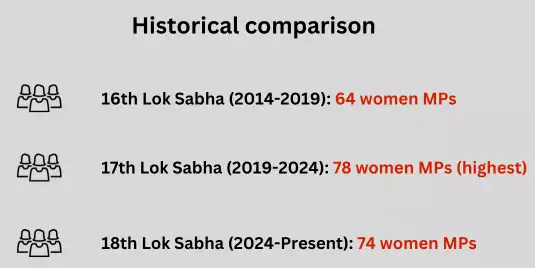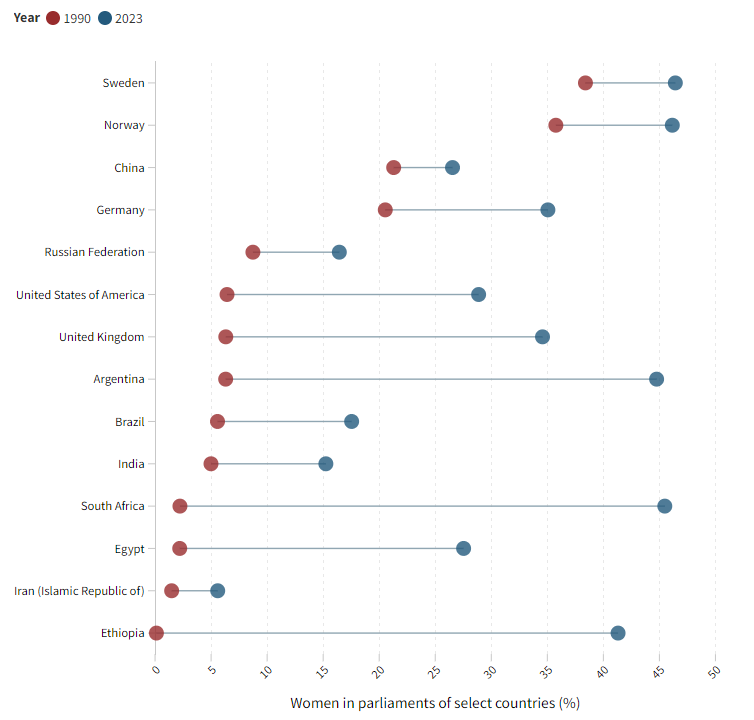Social Justice
Political Representation of Women
- 19 Jul 2024
- 8 min read
For Prelims: General Elections, Election Commission of India, Delimitation Commission, Political Parties, Reservation.
For Mains: Issue and Reasons for Low Representation of Women in Parliament, Issues Related to Women, Women's Issues, Inclusive Growth, Human Resource, Government Policies & Interventions, Women’s Reservation Act, 2023
Why in News?
The recently concluded general elections in the United Kingdom have seen a record 40% women representation in the House of Commons, highlighting the significant progress made by other countries in enhancing women's political participation.
- In contrast, India's women's representation in the Parliament remains well below the global average of 25%.
What is the Status of Women’s Representation in Indian Parliament?
- Women’s Representation in Parliament: In the Lok Sabha, the percentage of women members has risen from 5-10% until 2004 to 13.6% in the current 18th Lok Sabha, while in the Rajya Sabha, it is 13%.

- Also, the number of women contesting elections has shown a gradual increase over the past 15 years.
- In 1957, just 45 women candidates were contesting the Lok Sabha election; in 2024 there were 799 (9.5% of the total candidates contested).
- West Bengal leads in electing the most women MPs, with 11 representatives. The Trinamool Congress has the highest proportion of women among its Lok Sabha MPs, at 38% in the 18th Lok Sabha.
- This is far below the global average of around 25%.
- Also, the number of women contesting elections has shown a gradual increase over the past 15 years.
- Women’s Representation in State Legislatures: The national average of women's representation in State Legislative Assemblies stands at a mere 9%, with no state having more than 20% women legislators.
-
Even Chhattisgarh, the state with the highest representation, has only 18% women MLAs.
-
-
Global Scenario: India ranks 143 out of 185 countries in terms of women's representation in the lower house of Parliament.
- Sweden has 46% female MPs, South Africa (45%), the UK (40%) and the US (29%).
- India lags behind countries like Vietnam, the Philippines, Pakistan, and China in gender representation.
What are the Reasons for the Underrepresentation of Women in Politics?
- Socio-Cultural Barriers: Patriarchal norms and gender stereotypes limit women's participation in politics. Household responsibilities and lack of family support, along with disparities in education and economic empowerment, especially in rural areas contributes to such barriers.
- Political Party Dynamics: Male-dominated parties often hesitate to field women candidates, relegating them to "safe" or "unwinnable" seats. The lack of internal quotas or affirmative action policies further hinders women's candidacy.
- Electoral System Challenges: The first-past-the-post system favours established male candidates with strong financial and organisational backing. High election costs and the prevalence of criminalisation and money power in politics further disadvantage women.
- Institutional and Legal Barriers: The delayed implementation of the 73rd and 74th constitutional amendments, which provide for one-third reservation for women in local bodies, has limited the pipeline of women entering politics.
- The repeated failure to pass the Women's Reservation Bill, which proposed 33% reservation for women in Parliament and state legislatures, is another major institutional barrier.
- Lack of Political Will: Insufficient prioritisation of women's political empowerment by major parties and lack of sustained pressure from women's movements and civil society perpetuate the status quo.
What are the Arguments in Favour of Women's Reservation in Indian Parliament?
- Enhancing Women's Political Representation: Currently, women's representation in Parliament is far below the global average of around 25%. A 33% reservation would help bridge this gap and ensure a more equitable representation of women in the Indian Parliament.
-
Promoting Gender Equality and Inclusive Governance: Women in India face socio-cultural, economic, and political barriers to political participation, including patriarchal norms, lack of resources, and gender-based violence.
- Also, they make up nearly 50% of India's population but are underrepresented in political decision-making. Increasing their representation would lead to more gender-sensitive policies and better address the unique challenges women face.
- Strengthening Democratic Participation: Reserving one-third of seats for women would empower their active participation in politics, strengthen inclusive democracy and will initiate more women and children-centric policies that will help in human development.
- For instance, in many villages, women representatives have played a crucial role in eradicating child marriage, improving maternal health, and ensuring access to clean drinking water.
What Measures Have Been Taken to Address the Underrepresentation of Women in Indian Politics?
- Constitutional Amendments:
-
The 73rd and 74th Constitutional Amendments (1992/1993) provided for one-third reservation of seats for women in Panchayats and Municipalities, increasing their participation in local governance.
- The 106th Constitutional Amendment (2023) proposes a one-third reservation of seats for women in the Lok Sabha and state legislative assemblies, though its implementation is contingent on the next delimitation exercise.
- The reservation will be implemented after the first census following the commencement of the 106th Amendment Act including a delimitation exercise.
-
- The Women's Reservation Bill:
- The bill, first introduced in 1996, proposed 33% reservation for women in the Lok Sabha and state legislative assemblies. Despite several attempts, the bill has not been passed due to a lack of political consensus among major parties.
- Voluntary Party Quotas: Several political parties in India have female representation in their candidates for elections.
- The Naam Tamilar Katchi stands out with 50% women candidates, followed by Lok Janshakti Party and Nationalist Congress Party with 40% each.
- Jharkhand Mukti Morcha, Biju Janata Dal, and Rashtriya Janata Dal had 33%, 33%, and 29% female representation, respectively.
- Meanwhile, the Samajwadi Party had 20% and All India Trinamool Congress had 25% women candidates.
- Empowerment Schemes and Programs:
- Initiatives like the Mahila Shakti Kendra, Beti Bachao Beti Padhao, and STEP have aimed to improve women's socio-economic status, but have had limited direct impact on enhancing their political participation.
- Civil Society and Women's Movements:
- There has been sustained advocacy by women's rights groups, activists, and organisations for greater political representation.
|
Drishti Mains Question: What are the major challenges hindering women's representation in politics in India and what measures can be taken to overcome them? |
UPSC Civil Services Examination Previous Year Question
Q.1 What are the continued challenges for Women in India against time and space? (2019)
Q.2 Discuss the desirability of greater representation to women in the higher judiciary to ensure diversity, equity and inclusiveness. (2021)







